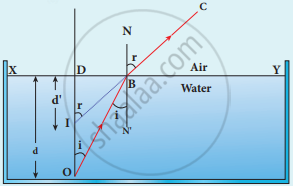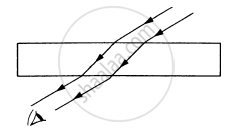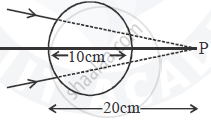Advertisements
Advertisements
प्रश्न
Obtain the equation for apparent depth.
उत्तर
Light from object O at the bottom passes from denser (water) to rarer medium (air).
n1 and n2 are refractive of denser and rarer medium.
By snells law
n1 sin i = n2 sin r
sin i ≈ tan i, as i and r are small
n1 tan i ≈ n2 tan i
`"n"_1 "DB"/"DO" = "n"_2 "DB"/"DI"`
`"n"_1/"d" = "n"_2/"d'"`
`"d'"/"d" = "n"_2/"n"_1`
`"d'" = "n"_2/"n"_1 xx "d"`
If n2 = 1 and n1 = n
d' = `"d"/"n"`
d' - d = d`(1 - 1/"n")`

Apparent depth
APPEARS IN
संबंधित प्रश्न
The refractive index of diamond is much greater than that of ordinary glass. Is this fact of some use to a diamond cutter?
A narrow beam of light passes through a slab obliquely and is then received by an eye following figure. The index of refraction of the material in the slab fluctuates slowly with time. How will it appear to the eye? The twinkling of stars has a similar explanation.

A vessel contains water up to a height of 20 cm and above it an oil up to another 20 cm. The refractive indices of the water and the oil are 1.33 and 1.30 respectively. Find the apparent depth of the vessel when viewed from above.
A convex lens of focal length 20 cm and a concave lens of focal length 10 cm are placed 10 cm apart with their principal axes coinciding. A beam of light travelling parallel to the principal axis and having a beam diameter 5.0 mm, is incident on the combination. Show that the emergent beam is parallel to the incident one. Find the beam diameter of the emergent beam.
A converging beam of light travelling in air converges at a point P as shown in the figure. When a glass sphere of refractive index 1 . 5 is introduced in between the path of the beam, calculate the new position of the image. Also draw the ray diagram for the image formed.

What is critical angle and total internal reflection?
The critical angle for a ray of light from glass to air is 'θ' and refractive index of glass with respect to air is 'n'. If a ray of light is incident from air to glass at an angle 'θ', then corresponding angle of refraction is ______.
When a ray of light is incident normally on one refracting surface of an equilateral prism of refractive index 1.5, the emerging ray ______.
`[sin^-1(1/1.5)=41.8^circ]`
There are certain material developed in laboratories which have a negative refractive index (Figure). A ray incident from air (medium 1) into such a medium (medium 2) shall follow a path given by.
Consider an extended object immersed in water contained in a plane trough. When seen from close to the edge of the trough the object looks distorted because ______.
- the apparent depth of the points close to the edge are nearer the surface of the water compared to the points away from the edge.
- the angle subtended by the image of the object at the eye is smaller than the actual angle subtended by the object in air.
- some of the points of the object far away from the edge may not be visible because of total internal reflection.
- water in a trough acts as a lens and magnifies the object.
